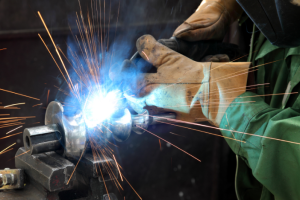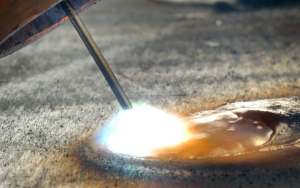Flux core welding is used by welders for its speed and flexibility, ideal for outdoor conditions and thick materials up to 1/2 inch.
Understanding Flux Core Welding
Basics of Flux Core Welding
Flux core welding is a type of electric arc welding that uses a tubular wire filled with flux material to weld metals. It is unique because it can be performed with or without a shielding gas, depending on the type of flux-core wire the welder is using. The wire’s core materials are designed to inhibit the oxidation process that can weaken the weld, increasing the quality of, and life of the weld joint. The key features of flux core welding techniques include high welding speed and mobility that make it suitable for outdoor use, and it does not need additional shielding gas in contrast to traditional welding methods because it provides both heat and filler metal to the weld . With those features, the welder can make up to 40 inches per minute of welding, where TIG welding under the average conditions can make only about 5-10 inches per minute.
Advantages of Flux Core Welding
There are several benefits of flux core welding processes that make it the best choice for fields like construction or car rebuilding/painting.
Increased Efficiency: Welders can generally achieve high deposition rates with flux core welding. Deposition rates of over 8 pounds per hour with a peak of 25 has been reported in some cases at 100% duty cycle . MIG welding, on the other hand, may generally achieve only 5 pounds per hour under optimal conditions
Versatility in Materials: The welding process can be done with a variety of metals and alloys. It is especially beneficial for penetration into thicker materials, thus it can create stronger welds . Flux core welding can be a good and easy choice for steel thickness that exceeds 1/2 inch, which might be a tough task for MIG or TIG welding.
Superior Outdoor Performance: This type of welding is less prone to wind and other environmental factors. Flux core welding is resistant to the drafts and crosswinds that may disperse a shielding gas. This property makes it more reliable for outdoor welding purposes because it allows the welder to control and direct the weld in the direction he wants.
Economical Cost: The setup cost is proportional to MIG or TIG welding setup cost, and the higher deposition rates with the flux core welding reduces the total cost. The cost of the shielding gas in MIG or TIG welding can make the overall project cost higher, especially in large-scale or outdoor projects.

Types of Flux Core Welders
One of the common uses of unified host and using different technology to weld a large piece of material which requires the use of different types of welders. Unified host aims to utilize a single technology in a welding machine for the efficient working of several processes in a single welding machine, they execute different technologies to produce a desired results. Otherwise, it will be cumbersome for using different machines for each different process which makes the process less efficient and this type has various applications. One of the common unified hosts which require a flux core wire will also require a separate tank as a secondary process such as, TIG which necessitates a gaseous tank to perform the job. Flux Cored Unified Host having the following specified attributes such as intermediate speed has an average output range which can weld the material having a thickness between thin and thick, it produces efficient and smooth post box welding of the material with high integrity and it consists of a spool gun .
Another unified host option which will need a flux core wire in one feeder and a remarked smooth, does not need any difference. Gas Shielded Flux Metal Arc Unified Host which produces a high speed output with a range between thick and very thick material. It produces a smooth, post box welded output at a high integrity level. It is suitable for training as since it is the best welding machine for school purposes. A third unified host option is a wire-feed system known as an electric welding machine which is the best option for the completion of the project. It does not require any marked difference as it has a simple approach to out play the other two options in the same cost range which also produces AP invented welding of the post boxes.
Flux Core Welding Equipment
Welding Machines for Flux Core
Flux core welding machines differ by capacity, size, and power, which also influences the functioning ability, delivering results. Regularly the machines have 90 to 250 amps as a welding power. Compare 140-amp power welder, which is enough for area house repairing and lightweight industrial usage. The users succeed to weld up to 1⁄4 inches thick materials. Higher-amp machines provide working with thicker materials up to 1⁄2 inches in one pass. There is a range of flux core welding machines according to their weld ability and price. For instance, the simplest machines are found for $200 cost for hobbyists and lightweight-welding repairers, whilst heavy-machines for industrial usage include up to $1,000 . It presupposes the welder’s needs according to the welding and, at an equivalent time, the opportunities, which higher-amp machines offer.
Essential Accessories for Flux Core Welding
Welders will need the following tools to ensure that flux core welding is efficient:
-
Welding Helmet – The helmet with the highest quality of auto-darkening serve welders with proper head and eyes protection from light during welding. There are several types of welding helmets, which depend upon the quality and on the features of the welding head protection. It ranges from $50 up to $300 . Designers advise a welding helmet with a touch bigger viewport, because from side-to-side views, the welders get the full appeal of what they’re doing.
-
Welding Gloves – Welding gloves ranges from $10 up to $40 according to the protection and style.
-
Welding Jacket – The users of these accessories need jacket or apron for the upper body protect. The jacket can be found starting from $30 up to $100 cost according to the material and quality of the jacket.
-
Wire Brushes and Chipping Hammers – These tools are utilized in cleaning the weld area after the welding for the preparation before another welding. The price ranges from $15 up to $30.
-
Magnetic Welding Clamps – Welder uses these clamps to stay the metals from moving when weld them. Prices range from $20 up to $50.
Thus, the variety of the accessories provided significantly influences the method of welding. In this concern, the standard higher quality provides better safety policy, also because the efficiency. Typically, quality tools might cost considerably. However, their utilization facilitates the upgrade of the weld quality, prognosis productivity, and makes sure of the enhanced level of safety.

Materials Compatible with Flux Core Welding
When you think of flux core welding, you probably think of carbon steel. It is perhaps the most compatible metal for this type of welding, as it allows the process to cut deep, wide, and fast, forming firm welds. Thanks to its benefits in terms of speed, penetration, and material thickness, this is likely the most commonly welded metal in this way. Welding sheets of differing thicknesses? Whether you’re working with thin sheet metal or a several-inch-thick slab, carbon steel will become your second favorite metal when working with a flux core welder.
Stainless steel may also benefit from this form of welding due to the decreased chances of warping when using a wire-based welding technique. This form of welding is particularly helpful in this regard because it decreases the likelihood of corrosion to non-weathered stainless steel. When welding the image variance, be wary: there is a solid flux core wire that corresponds to the form of the wire itself.
What About Aluminum?
Unlike the two metals already mentioned, flux core welding can be used for aluminum. However, the process requires specific types of flux core wire for this, as well as a welding machine ready for it. However, due to its high feed sensitivity and heat conductivity, aluminum is typically more difficult to deal with than other types of workpieces like carbon and stainless steel. Regardless, you are less likely to weld aluminum in a workshop than you are to weld one of the other metals.
Why Might a Flux Core Welder Not Work with My Material?
Unfortunately, as much as we wish they could, flux core welders cannot accommodate all instruments. A flux core welder is likely to struggle when welding a tool of higher material thermal conductivity such as copper. Its heat conductivity can be prevented from taking the heat influx it needs when obstructions are removed or extra equipment is included in the form of pre-kindling. Since flux core welding is associated with a high level of heat, any metal thinner than 20 is more likely to produce warping or burn-through of the flame and is generally not recommended. Any metal you use in a homeowner’s workshop will mean you need to implement specific technique modifications!




